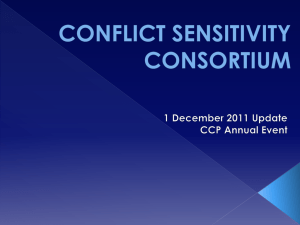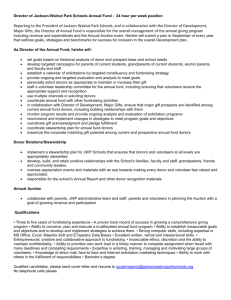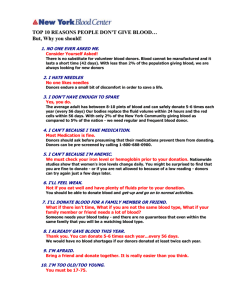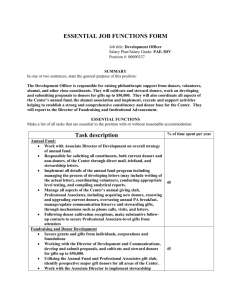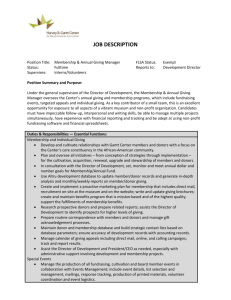Comparative-analysis-of-the-common-standard
advertisement
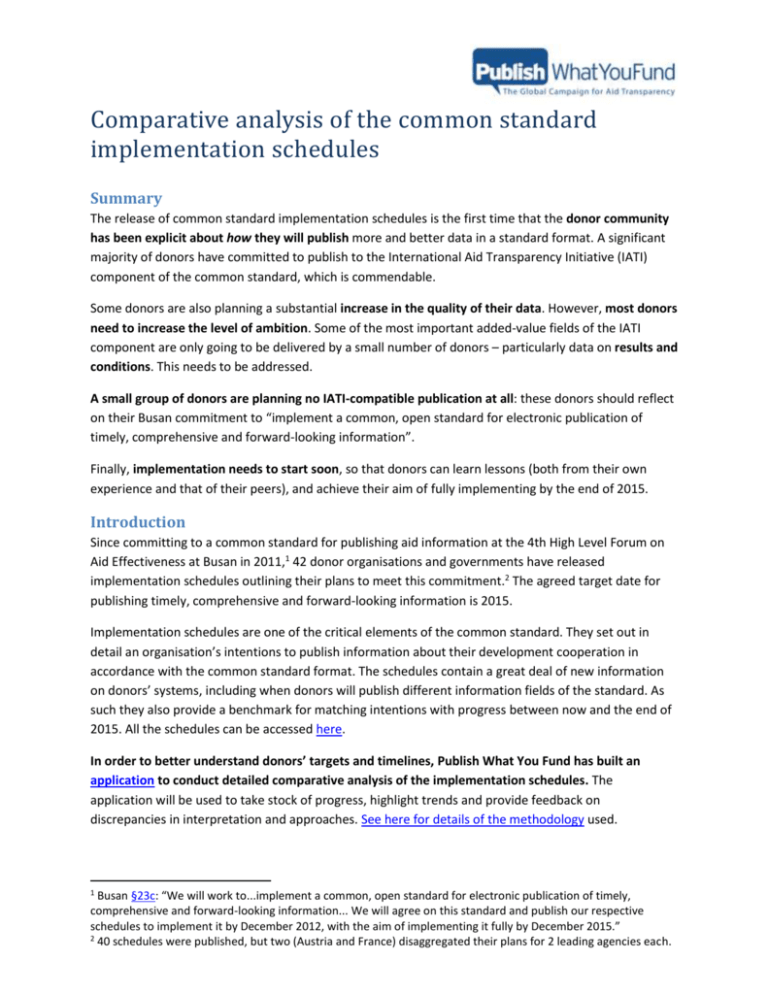
Comparative analysis of the common standard implementation schedules Summary The release of common standard implementation schedules is the first time that the donor community has been explicit about how they will publish more and better data in a standard format. A significant majority of donors have committed to publish to the International Aid Transparency Initiative (IATI) component of the common standard, which is commendable. Some donors are also planning a substantial increase in the quality of their data. However, most donors need to increase the level of ambition. Some of the most important added-value fields of the IATI component are only going to be delivered by a small number of donors – particularly data on results and conditions. This needs to be addressed. A small group of donors are planning no IATI-compatible publication at all: these donors should reflect on their Busan commitment to “implement a common, open standard for electronic publication of timely, comprehensive and forward-looking information”. Finally, implementation needs to start soon, so that donors can learn lessons (both from their own experience and that of their peers), and achieve their aim of fully implementing by the end of 2015. Introduction Since committing to a common standard for publishing aid information at the 4th High Level Forum on Aid Effectiveness at Busan in 2011,1 42 donor organisations and governments have released implementation schedules outlining their plans to meet this commitment.2 The agreed target date for publishing timely, comprehensive and forward-looking information is 2015. Implementation schedules are one of the critical elements of the common standard. They set out in detail an organisation’s intentions to publish information about their development cooperation in accordance with the common standard format. The schedules contain a great deal of new information on donors’ systems, including when donors will publish different information fields of the standard. As such they also provide a benchmark for matching intentions with progress between now and the end of 2015. All the schedules can be accessed here. In order to better understand donors’ targets and timelines, Publish What You Fund has built an application to conduct detailed comparative analysis of the implementation schedules. The application will be used to take stock of progress, highlight trends and provide feedback on discrepancies in interpretation and approaches. See here for details of the methodology used. 1 Busan §23c: “We will work to...implement a common, open standard for electronic publication of timely, comprehensive and forward-looking information... We will agree on this standard and publish our respective schedules to implement it by December 2012, with the aim of implementing it fully by December 2015.” 2 40 schedules were published, but two (Austria and France) disaggregated their plans for 2 leading agencies each. Why an implementation schedule? Before reviewing the results, it is important to understand their purpose and importance. Why is an implementation schedule an important component of organisational transparency? Are the schedules an accurate reflection of donor intentions? How should we use and interpret the schedules? The original IATI Framework for Implementation, which all organisations agree to when signing IATI, envisaged implementation schedules as a way of setting out publicly how donors would meet their Accra (and now Busan) commitments, including meeting the standard. This open process was adopted for the common standard and allows organisations to set out the opportunities and constraints they face in their own jurisdictions. Publicly committing to a combination of greater disclosure and technical improvements is a novel process for many organisations, requiring a significant culture shift internally. Living documents These initial schedules are an important step in the transparency process and are a way to measure an organisation’s ambition to meet the Busan goals. It is possible that some organisations are not being as ambitious in their schedules as they intend to be with actual implementation. Others have over-sold their existing delivery or conflated publication in general with timely publication to the common standard. All organisations should continue to review and improve their schedules in light of their peers’ plans and to clarify inconsistencies and ambiguities. We will then re-assess the schedules later in the year following this review and consultation. A methodology for measuring ambition Each schedule was assessed and scored based on plans for delivering the IATI component of the common standard – focusing on the fundamental role of timely and open data and the needs of partner countries and non-state actors. The assessment was conducted in three dimensions: 1. Intention to publish (current, comparable data) by 2015; 2. Publication approach (frequency and open data licence); 3. Proportion of data fields to be delivered by end of 2015. We grouped donors’ plans as follows: Ambitious Moderately ambitious Unambitious Under consideration Incomplete No publication (of current, comparable data) Asian Development Bank Denmark Netherlands UNDP World Bank African Development Bank Hewlett Foundation New Zealand World Food Programme Australia Switzerland United States France (AFD & MAE) Luxembourg Austria (ADA & BMeiA) Portugal 2 Belgium EuropeAid Norway UK-DFID Canada Inter-American Development Bank Sweden UNOPS Czech Republic IFAD Spain Finland Ireland UNICEF Germany UNFPA Slovak Republic UK-CDC Italy Poland Greece Slovenia Japan Korea (Ex-Im Bank) A note on “ambitious” – some donors are working towards compliance in 2013 or 2014, whereas others will not deliver until 2015. To keep the methodology simple, we have not scored early implementation higher than implementation in 2015. This also recognises that donors have committed to full implementation of the common standard by the end of 2015. (See here for scoring.) We welcome feedback on the interpretation of the schedules. Issues with the template This exercise has underlined the paramount importance of common standards and definitions. While there is an agreed template for the common standard implementation schedules, several different versions of the template exist, with donors adding to this complexity by modifying it, changing options, and adding and deleting rows – in total, eleven different versions have been used and had to be supported by the application. This created difficulties in analysing the information and necessitated considerable interpretation to ensure consistency and comparability across the schedules (see “About” section on the application). Of greater concern, it highlights significant divergence in interpretation and delivery – the very thing that a common standard is designed to avoid. Donors' different approaches to the schedule It is evident that some donors have taken a conservative approach, by leaving much of the schedule blank (e.g. Poland). Other donors have potentially understated the ambition of some of their own agencies (by not specifying those which can publish certain fields), where information fields are not feasible from all of their agencies (e.g. the U.S.). Donors have made liberal use of the “not applicable” option. This option is certainly valid in several data fields – those fields that are only sometimes applicable to organisations publishing to IATI have been excluded from the scoring and final analysis. However, some donors have stated that fields such as results, conditions and even activity budgets are “not applicable”, though rarely with any explanation. We can deduce that donors have chosen “not applicable” in such cases for three broad reasons: Where information is available but seen as redundant or repetitive. In situations where the organisation’s business model defines the answer (e.g. for “tied aid status”, where tying under DAC definitions is not possible), those organisations do not always realise the utility of completing the field (which is necessary for a complete dataset on tying across donors, sectors and countries). Misinterpretation. Where the meaning of the field has been misinterpreted (e.g. implementing organisations). For example, some donors excluded funding organisation, even though the funding organisation is (in almost all cases) simply that donor. In error. Donors often used “not applicable” when a more accurate status would have been “not publishing now”. There is also some confusion about certain data fields or groups of fields, especially “participating organisation” – implementing, funding, extending and accountable – and between “other activity identifiers” and “related activities”. More generally, the schedules do not distinguish whether the organisation intends to implement specific fields according to the IATI approach (e.g. timely and in the IATI-XML format), on account of the overlap between a portion of the CRS and IATI fields. 3 Some traditional donors have yet to release their implementation schedules. These should be released as soon as possible, and non-traditional actors should be encouraged to test the applicability of the common standard by completing an implementation schedule. In some extreme cases, donors have refused to entertain implementation of the IATI components (Austria, Greece, Korea, Portugal and Slovenia). These donors need to address their commitments made at Busan in November 2011. Main findings…for now It is important to highlight that we do not consider these schedules as final. For many donors, it is the first time completing such a public, technical document. This is only an initial survey; improvement is expected as donors become more familiar with the template and update their schedules accordingly. We hope that some of the lessons learned as part of this comparative review will support that process. Key findings: 14 donor organisations plan to begin publishing to the IATI Registry by 2015, joining the 22 donors (and nearly 90 CSOs) that are already doing so. o This includes several bilateral donors that have not joined IATI to date: the Czech Republic, Luxembourg, Poland and the Slovak Republic. o All original IATI signatories will be publishing by end of 2013, including Germany and Norway. The majority of donors are committing to deliver most of the basic fields, but now in compliance with IATI’s format and approach. o The vast majority of donor agencies hold these fields in their systems and many report them to the DAC. Some will also publish this kind of basic activity information on their websites, though format and timeliness vary widely. Systematic publication of this information at least quarterly and in the same format will provide a clearer picture of current donor activity. o Over 60% of donors with a schedule are planning to publish the following fields: recipient country (e.g. Malawi) reporting organisation (e.g. CIDA) flow type (e.g. ODA) finance type (e.g. grant) activity start and end dates (e.g. 2004-09-15 & 2012-04-02) activity title (e.g. “Appui au secteur de l'éducation/Support to the Education Sector”) recipient region (e.g. South of Sahara, regional) sector (e.g. education policy and administrative management) aid type (e.g. sector budget support) tied aid status (e.g. untied) o All donors should be delivering these basic fields in their first publication to IATI. Around half of the donors planning to publish IATI components have no plans to publish forwardlooking data on country and organisation budgets. Of those who are planning to publish this data, several will be doing so only for a year at a time, falling short of the 3-5 year requirement of the standard, an important nuance that is generally not captured in the common standard schedule. Future versions of the schedule should be more explicit about this. 4 Frequency of publication, the main demand from partner countries, is not being sufficiently prioritised. Several donors are committing to the IATI approach and the majority of the data fields but are failing to commit to quarterly publishing, the minimum required for use by partner country governments in their budget planning.3 There is a lack of commitment to publishing timely and comparable information on performance. Only 17% of organisations are currently planning to include results and conditions data, despite explicit Busan commitments and donors’ own political prioritisation of results by donor agencies. All donors should be planning to collect and begin publishing this information over the next 2 years. A significant proportion of donors with a schedule are committed to three particularly high-value fields: transactions (disbursements), implementing organisations and activity documents.4 o When completed correctly, these will provide new (and timely) comparable information on: individual, dated disbursements from the donor; the partners/recipients that receive those funds down the delivery chain; links to a huge range of rich data on project design, implementation and evaluation. o Publication of disbursements and implementing organisations will greatly increase traceability down the delivery chain. o While some activity documents are already published on agency or project websites, their inclusion (and categorisation) within the IATI dataset will make searching for document types across donors and countries much easier. For example, publication of project evaluations by all IATI-compliant donors would enable stakeholders to compare the effectiveness of different interventions and competing contractors. Emerging best practice Implementation schedules offer donors an innovative opportunity for dialogue with external stakeholders. This covers not only the types of information donors publish, but also their approach to publishing. Further iterations should be produced both after consultation and to reflect changing situations. For example, IT upgrades provide opportunities for automating IATI publication and national legislation (e.g. data licensing or confidentiality laws) can enable a more open approach. In the interests of dialogue and clarity, donors should provide textual explanations in cases where they cannot commit to publishing a field on a specific date. For example, in cases where several organisations are considering implementation of a more challenging field, notes on constraints will help to foster peer learning and collaboration, particularly in cases where donor agencies use the same database providers (e.g. SAP or Oracle), who could be asked to produce a bolt-on for many users. In cases where donors are “partially compliant”, it is helpful to give an explanation, not only to increase accountability for future implementation but also so that data users interpret current data correctly. For example, CIDA has explained its partial compliance for “activity status” as follows: “Implementation stage published as of Oct 2012, completion and post-completion to be published as of Jan 2013.” 3 Of the 32 organisations planning to implement the IATI components, 12 are not planning to publish at least quarterly and 2 have not specified frequency. 4 60% of donors with schedules have committed to transactions (disbursements/expenditure); participating organisation (implementing) is 52%; activity documents is 43%. 5 Fields where “future publication” is specified are also greatly enriched by a description. For example, Sweden’s future publication of results is described as followed: Results summaries will be published for new activities from May 2013. According to our other commitments in Busan around results we also plan to publish indicator-based targets and outcomes and other results and evaluations before 2015. This is constructive because it shows other donors how Sweden is tackling this important field that will be most useful if donors coordinate as far as possible their approaches to evaluation and results. Some agencies that have not begun publishing to IATI are taking serious steps towards compliance via open planning. For example, Belgium intends to implement much of the standard in June 2014, including many of the added value fields such as activity documents, conditions and results data. It is particularly welcome to see a country with a record for scrupulous reporting to the DAC embracing the IATI approach and scope with such determination. Recommendations – for donors 1. Donors should be more ambitious. There are some ambitious plans, including for forward-looking information, from both existing IATI publishers and donors newly approaching IATI components. But some appear to have treated this as a form-filling exercise. All donors should publish what they can as soon as possible; at the very least, all should begin implementing the IATI component of the common standard by 2014 so that they may aim to “fully implement” by the end of 2015. 2. More donors need to consider the added value fields of the standard (e.g. results). It is disappointing that there are currently such low levels of ambition for some of the fields that have the greatest potential. While donors may not yet capture this data in their systems in a structured way, the next two years are an opportunity to improve systems during regular IT upgrades. 3. Donors not planning to publish any information to the IATI component of the common standard should reflect on the commitments they made at Busan. These donors should explain how else they are planning to meet their commitment to “implement a common, open standard for electronic publication of timely, comprehensive and forward-looking information”. 4. Donors should regularly review and update their schedules to clarify inconsistencies and ambiguities, reflect ongoing changes in their own internal processes and ultimately demonstrate greater ambition to fulfilling their Busan commitments on aid transparency. Recommendations – for the common standard 1. One template with the correct formatting is essential for the common standard. The common standard should provide a clearer, more structured template, which will improve the comparability of the data and reduce the need for potentially inaccurate interpretations. 2. The template also needs to provide clearer definitions of fields and examples of how these are applied, particularly in cases where significant problems have occurred. Organisations should be encouraged to use the agreed template, to complete it as fully as possible and provide explanations for any field that is not “full compliant”. 6




